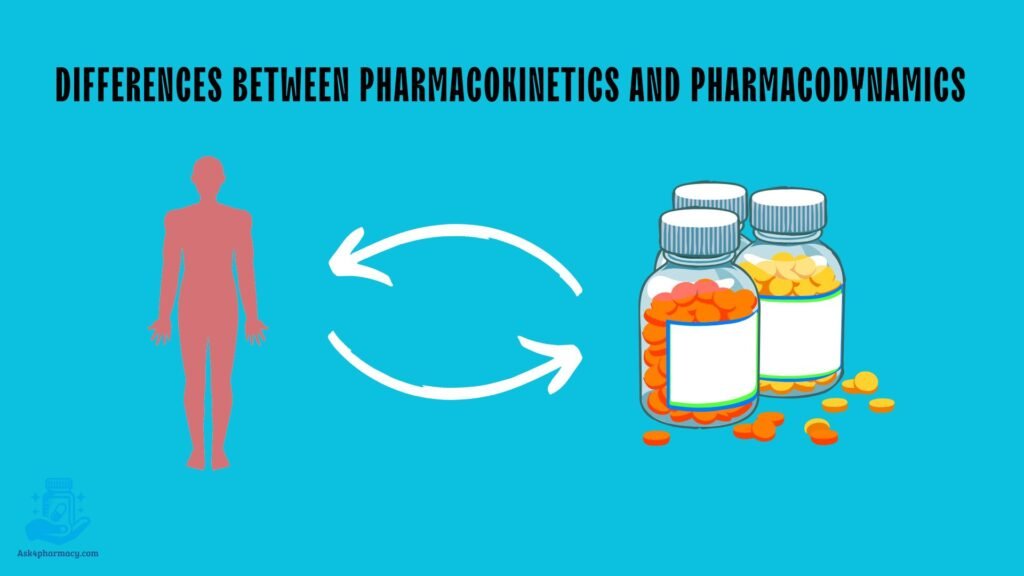Pharmacokinetics and Pharmacodynamics
Pharmacokinetics and pharmacodynamics are important concepts to know how drugs interact in the body. Whether you are a student, pharmacist, or someone interested in medicine, learning about these processes will give you valuable information on how medications can be beneficial.

What Is Pharmacokinetics?
Pharmacokinetics explains how a drug moves through the body. It focuses on what the body does to the drug and involves four key processes:

- Absorption
This is how the drug enters the bloodstream after administration. Factors such as the route of administration (oral, intravenous…) and the drug’s chemical properties affect absorption. - Distribution
Once absorbed, the drug travels through the bloodstream to reach various tissues and organs. The drug’s ability to bind to proteins or cross cell membranes influences its distribution. - Metabolism
The body breaks down the drug, often in the liver, to make it easier to eliminate. Metabolism can activate or deactivate the drug, depending on its properties. - Excretion
Finally, the body eliminates the drug, primarily through the kidneys (urine) or the liver (bile). The rate of excretion affects how long the drug remains effective.
Pharmacokinetics answers questions like:
- How quickly does the drug start working?
- How long does it stay active in the body?
What Is Pharmacodynamics?
Pharmacodynamics (PD) describes how the drug interacts with the body to produce its effects. It focuses on what the drug does to the body and involves two main aspects:
- Mechanism of Action
This explains how a drug produces its effects, such as binding to receptors, inhibiting enzymes, or altering cellular functions. - Dose-Response Relationship
This examines the relationship between the drug’s dose and the strength of its effect. It helps determine the minimum effective dose and the maximum safe dose.
Pharmacodynamics helps answer questions like:
- How does the drug work?
- What effects will it produce, and at what dose?
Differences Between Pharmacokinetics and Pharmacodynamics

While both concepts are related, they focus on different aspects of drug action:
- Pharmacokinetics is about how the body processes the drug.
- Pharmacodynamics is about how the drug affects the body.
Why Are These Concepts Important?
Understanding pharmacokinetics and pharmacodynamics is crucial for:
- Developing New Drugs: Scientists use these principles to create medications that are safe and effective.
- Personalized Medicine: Healthcare providers can tailor treatments based on how individual patients metabolize and respond to drugs.
- Avoiding Side Effects: Knowing how drugs work helps minimize adverse effects and drug interactions.
Real-Life Applications
For example:
- A drug with poor absorption might require a higher dose or a different route of administration.
- Medications that work on specific receptors can treat diseases like hypertension or asthma more effectively.
Conclusion
Pharmacokinetics and pharmacodynamics are the foundation of modern medicine, describing how drugs are processed and how they achieve their outcomes. By understanding these concepts, healthcare professionals and patients alike can make informed decisions regarding medication usage.
References :
- Brunton, L. L., Hilal-Dandan, R., & Knollmann, B. C. (2018). Goodman & Gilman’s: The Pharmacological Basis of Therapeutics (13th ed.). McGraw-Hill Education.
- A comprehensive reference on pharmacokinetics, pharmacodynamics, and drug actions.
- Rang, H. P., Dale, M. M., Ritter, J. M., Flower, R. J., & Henderson, G. (2019). Rang and Dale’s Pharmacology (9th ed.). Elsevier.
- Explains the principles of pharmacokinetics and pharmacodynamics in detail.
- U.S. Food and Drug Administration (FDA). (n.d.). Clinical Pharmacology. Retrieved from https://www.fda.gov
- Information on drug development and the importance of pharmacokinetics and pharmacodynamics.
- World Health Organization (WHO). (n.d.). Medicines: Pharmacovigilance and Drug Safety. Retrieved from https://www.who.int
- Highlights the role of pharmacokinetics and pharmacodynamics in ensuring medication safety.
- National Library of Medicine. (n.d.). Pharmacokinetics and Pharmacodynamics Overview. Retrieved from https://www.ncbi.nlm.nih.gov
- Detailed academic articles and research papers on drug behavior and action.
- Lexicomp Online. (n.d.). Pharmacokinetics and Pharmacodynamics in Clinical Practice. Retrieved from https://www.wolterskluwer.com
- Practical insights for healthcare professionals managing medications.
Discover More at Ask4pharmacy.com
About Pharmacist About Pharmacy Courses with Certificate Free Courses Pharmacist in Usa Work As Phramacist
Wonderful beat ! I would like to apprentice while you amend your site, how could i subscribe for a blog web site? The account aided me a acceptable deal. I had been a little bit acquainted of this your broadcast provided bright clear idea